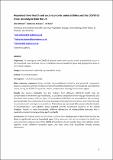Files in this item
Household level health and socio-economic vulnerabilities and the COVID-19 crisis : an analysis from the UK
Item metadata
| dc.contributor.author | Mikolai, Julia | |
| dc.contributor.author | Keenan, Katherine Lisa | |
| dc.contributor.author | Kulu, Hill | |
| dc.date.accessioned | 2020-05-20T12:30:07Z | |
| dc.date.available | 2020-05-20T12:30:07Z | |
| dc.date.issued | 2020-05-10 | |
| dc.identifier | 268058572 | |
| dc.identifier | 4dc0f422-ea86-4abd-9ba1-efe5a4ec9cfe | |
| dc.identifier.citation | Mikolai , J , Keenan , K L & Kulu , H 2020 ' Household level health and socio-economic vulnerabilities and the COVID-19 crisis : an analysis from the UK ' SocArXiv . https://doi.org/10.31235/osf.io/4wtz8 | en |
| dc.identifier.other | ORCID: /0000-0002-7733-6659/work/74510367 | |
| dc.identifier.other | ORCID: /0000-0002-9670-1607/work/74510390 | |
| dc.identifier.other | ORCID: /0000-0001-8808-0719/work/75997004 | |
| dc.identifier.uri | https://hdl.handle.net/10023/19971 | |
| dc.description.abstract | Objectives. To investigate how COVID-19-related health and socio-economic vulnerabilities occur at the household level, and how they are distributed across household types and geographical areas in the United Kingdom. Design. Cross-sectional, nationally representative study. Setting. The United Kingdom. Participants. ~19,500 households. Main outcome measures. Using multiple household-level indicators and principal components analysis, we derive summary measures representing different dimensions of household vulnerabilities critical during the COVID-19 epidemic: health, employment, housing, financial and digital. Results. Our analysis highlights three key findings. First, although COVID-19 health risks are concentrated in retirement-age households, a substantial proportion of working age households also face these risks. Second, different types of households exhibit different vulnerabilities, with working-age households more likely to face financial, housing and employment precarities, and retirement-age households health and digital vulnerabilities. Third, there are area-level differences in the distribution of vulnerabilities across England and the constituent countries of the United Kingdom. Conclusions. The findings imply that the short- and long-term consequences of the COVID-19 crisis are likely to vary by household type. Policy measures that aim to mitigate the health and socio-economic consequences of the COVID-19 pandemic should consider how vulnerabilities cluster together across different household types, and how these may exacerbate already existing inequalities. | |
| dc.format.extent | 14 | |
| dc.format.extent | 428381 | |
| dc.language.iso | eng | |
| dc.publisher | SocArXiv | |
| dc.subject | H Social Sciences (General) | en |
| dc.subject | HM Sociology | en |
| dc.subject | RA0421 Public health. Hygiene. Preventive Medicine | en |
| dc.subject | SDG 3 - Good Health and Well-being | en |
| dc.subject.lcc | H1 | en |
| dc.subject.lcc | HM | en |
| dc.subject.lcc | RA0421 | en |
| dc.title | Household level health and socio-economic vulnerabilities and the COVID-19 crisis : an analysis from the UK | en |
| dc.type | Working or discussion paper | en |
| dc.contributor.institution | University of St Andrews. School of Geography & Sustainable Development | en |
| dc.contributor.institution | University of St Andrews. Sir James Mackenzie Institute for Early Diagnosis | en |
| dc.identifier.doi | https://doi.org/10.31235/osf.io/4wtz8 |
This item appears in the following Collection(s)
Items in the St Andrews Research Repository are protected by copyright, with all rights reserved, unless otherwise indicated.

